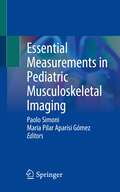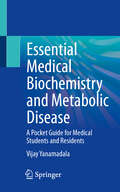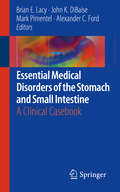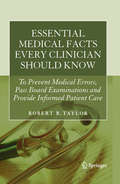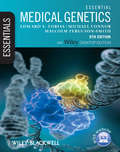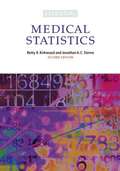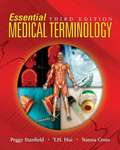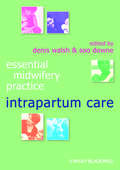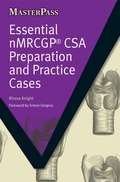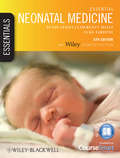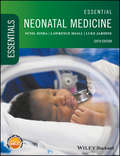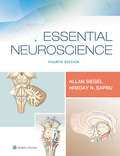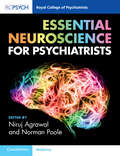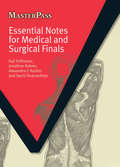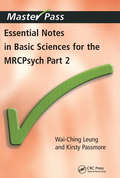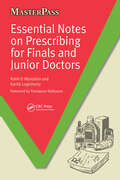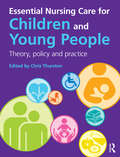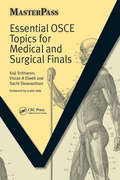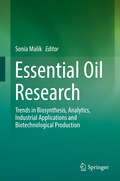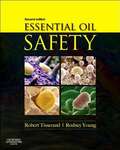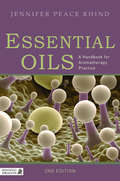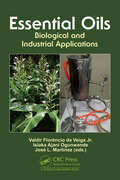- Table View
- List View
Essential Measurements in Pediatric Musculoskeletal Imaging
by Paolo Simoni Maria Pilar Aparisi GómezThis practical guide presents an up-to-date, comprehensive yet concise collection of the most frequently used measurements in musculoskeletal studies carried out in children and adolescents through the different radiological modalities.The book covers the measurements applied on various anatomical regions in a succinct and easy-to-use structure, with additional chapters dedicated to specific techniques and focused evaluations. It provides radiological images, informative drawings, and diagrams to describe each measurement and explain its applications and role in specific diseases. Also, the book identifies potential difficulties regarding positioning and techniques and offers tips to avoid misinterpretation.The book is a handy reference for everyday use and helps practitioners evaluate pediatric musculoskeletal studies by providing precise instructions on how to perform accurate measurements and interpret them to obtain an accurate diagnosis.
Essential Medical Biochemistry and Metabolic Disease: A Pocket Guide for Medical Students and Residents
by Vijay YanamadalaThis practical, pocket-sized guide presents everything that a medical student needs to know to master the biochemistry and human metabolism content for the USMLE Step 1. It is a clear concise review of these topics in an easy to understand and digestible format. Each of the five sections provides high-yield information on the essentials of carbohydrate, lipid, protein, nucleotide and vitamin metabolism, respectively, including diagrammatic figures and tables for at-a-glance referral.
Essential Medical Disorders of the Stomach and Small Intestine: A Clinical Casebook
by Mark Pimentel Alexander C. Ford Brian E. Lacy John K. DiBaiseThis casebook provides a concise yet comprehensive state-of-the art review of common stomach and small intestine disorders. The casebook is divided into five parts, each of which focuses on a major disorder, symptom, or clinical scenario related to the stomach and small intestine, including dyspepsia, small bowel disorders, nausea and vomiting, chronic abdominal pain, and post-operative GI surgery challenges. Each part is comprised of cases illustrating different aspects of the subject, with each case containing sections on case presentation, objectives, epidemiology and etiology, diagnostic evaluation and treatment, case follow-up, clinical pearls, and Q&A. Some major topics presented in these cases include nausea and vomiting in the pregnant patient, gas-bloat, functional abdominal pain, post-GI surgery complications, and celiac disease and non-celiac gluten sensitivity. Written by internationally renowned experts in the field, Essential Medical Disorders of the Stomach and Small Intestine: A Clinical Casebook is a valuable resource for clinicians and practitioners who treat patients afflicted with disorders of the stomach and small intestine.
Essential Medical Facts Every Clinician Should Know
by Robert B. TaylorEssential Medical Facts presents selected literature-based information clinicians need to know to provide informed patient care and avoid medical misadventures. Facts that can help make us better and safer clinicians include knowing the usefulness of palmar crease pallor in detecting anemia (not reliable), antibiotics that can cause a false positive opiate urine drug screen (fluoroquinolones), and an occasional early clue to testicular cancer (gynecomastia). Of course, keeping up to date on current medical knowledge and being curious about the implications of published research conclusions not only help assure superior clinical performance; they also bolster the preparation for board examinations. Robert B. Taylor, MD is the author and editor of more than two dozen medical books and several hundred published articles, as well a veteran of both rural private practice and chairmanship of a medical school clinical department. Essential Medical Facts is written for clinicians in all specialties, at all stages of professional life. It is a "must have" book for students, residents and practicing physicians, as well as nurse practitioners and physician assistants actively involved in clinical diagnosis and management of disease.
Essential Medical Genetics (Essentials #22)
by Edward S. Tobias Michael Connor Malcolm Ferguson-SmithAdopted at Cambridge University Essential Medical Genetics provides students, clinicians, counsellors and scientists with the up-to-date information they need regarding the basic principles underlying medical genetics. It also provides guidance on how to apply current knowledge in clinical contexts, covering a wide variety of topics: from genome structure and function to mutations, screening and risk assessment for inherited disorders. This sixth edition has been substantially updated to include, for instance, the latest information on the Human Genome Project as well as several new molecular genetic and chromosome analysis techniques. In full colour throughout, it includes a number of brand new features, including: a large number of self-assessment questions; 'Essentials' chapter summaries; further reading suggestions; and case study scenarios introducing clinical situations. An invaluable new section gives illustrated practical advice regarding how to choose the best available online genetic databases and also, importantly, how to most easily and most efficiently use them, for a wide range of purposes. Essential Medical Genetics is the perfect resource for a course on medical genetics, and is now accompanied by a regularly updated website and the FREE enhanced Wiley Desktop Edition (upon purchase of the book). The companion website at www.wiley.com/go/tobias features figures from the book in PowerPoint format and a link to the authors' website with regularly updated links to genetic databases and additional self-test questions. This title is also available as a mobile App from MedHand Mobile Libraries. Buy it now from iTunes, Google Play or the MedHand Store.
Essential Medical Statistics
by Betty R. Kirkwood Jonathan A. C. SterneBlackwell Publishing is delighted to announce that this book has been Highly Commended in the 2004 BMA Medical Book Competition. Here is the judges' summary of this book: "This is a technical book on a technical subject but presented in a delightful way. There are many books on statistics for doctors but there are few that are excellent and this is certainly one of them. Statistics is not an easy subject to teach or write about. The authors have succeeded in producing a book that is as good as it can get. For the keen student who does not want a book for mathematicians, this is an excellent first book on medical statistics." Essential Medical Statistics is a classic amongst medical statisticians. An introductory textbook, it presents statistics with a clarity and logic that demystifies the subject, while providing a comprehensive coverage of advanced as well as basic methods. The second edition of Essential Medical Statistics has been comprehensively revised and updated to include modern statistical methods and modern approaches to statistical analysis, while retaining the approachable and non-mathematical style of the first edition. The book now includes full coverage of the most commonly used regression models, multiple linear regression, logistic regression, Poisson regression and Cox regression, as well as a chapter on general issues in regression modelling. In addition, new chapters introduce more advanced topics such as meta-analysis, likelihood, bootstrapping and robust standard errors, and analysis of clustered data. Aimed at students of medical statistics, medical researchers, public health practitioners and practising clinicians using statistics in their daily work, the book is designed as both a teaching and a reference text. The format of the book is clear with highlighted formulae and worked examples, so that all concepts are presented in a simple, practical and easy-to-understand way. The second edition enhances the emphasis on choice of appropriate methods with new chapters on strategies for analysis and measures of association and impact. Essential Medical Statistics is supported by a web site at www.blackwellpublishing.com/essentialmedstats. This useful online resource provides statistical datasets to download, as well as sample chapters and future updates.
Essential Medical Terminology (3rd edition)
by Peggy Stanfield Nanna CrossThis best-selling introduction to medical terminology text is flexible enough to be used in a traditional or a self-instructional course format. Suited for students of all levels in the allied health professions, this text provides the appropriate amount of detail needed to learn the basics of medical terminology. After studying the fundamentals of pronunciation, students can study the chapters in any order the instructor deems appropriate The Third Edition also includes a new chapter on Cancer Medicine and a user-friendly CD-ROM with interactive flashcards, crossword puzzles, and additional exercises. This text with helpful online resources is highly accessible for all health care students, offering a wealth of valuable information at an attractive price. Read the Preface And The Guidelines on How to Use This Book! Do you want to provide your Medical Terminology students with an easy-to-use online learning experience? Our new JBCourseManager is a free online resource when you adopt! JBCourseManager for Essential Medical Terminology, Third Edition features: Pre-loaded instructor resources as well as the function to upload your own Medical search term function Medical term of the day Ability to add your own assignments, quizzes, wikis, workshops, blogs, etc. , and change or remove the pre-loaded content Links to medical term pronounciation Accessible calendar with "upcoming events" reminders Threaded discussion forums, live chat sessions, and instant messaging capabilities Unique discussion forum setting, known as our "Q&A", cuts down on students copying answers Comprehensive reports to view all student activity Complete Companion Website with a vast array of resources including audio files
Essential Midwifery Practice
by Denis Walsh Soo DowneIntrapartum care has undergone profound changes over the past fifty years. Essential Midwifery Practice: Intrapartum Care takes a broad sweep to examine these changes and their intersection with midwifery, in particular their impact on the midwife's role during labour and birth. It is an invaluable guide for all midwives.Essential Midwifery Practice: Intrapartum Care addresses a wide range of topics including the evolution of intrapartum care, debates about knowledge, and childbirth education. It looks at birth environments, labour rhythms, working with pain, normal birth, unusual labours, and complementary therapies. Written by key experts and providing guidance on best practice, this unique and diverse text will bring readers up-to-date with the latest research and reflection in their specialist fields.Written by key experts in their respective fields coming together for the first timeProvides comprehensive examination of normal birth practiceEvidence-based, bringing you up-to-date with the latest research
Essential NMRCGP CSA Preparation and Practice Cases (MasterPass)
by Rhona KnightThe Clinical Skills Assessment (CSA) of the new Membership of the Royal College of General Practice (nMRCGP) examinations can be a daunting test: candidates face assessment on an unknown situation by a 'patient' and assessor, however, help is at hand. This book has been written by a CSA examiner in concert with GP training programme members to help candidates approach the exam feeling prepared, calm and in control. It includes advice on preparation, consultation skills, how the assessment is marked, and 12 practice CSA cases, along with advice on how candidates can create cases with which to practise and assess each other. Clear, practical, and based on sound knowledge and proven techniques, this book will be essential reading for nMRCGP CSA candidates. 'Rhona is a passionate and compassionate educator with a strong sense of natural justice, and also a long-standing MRCGP examiner. She has developed an approach to understanding and preparing for the Clinical Skills Assessment (CSA) that is already tried, tested and proven. An approach that will enhance the candidate's ability as a GP at the same time as preparing them for the CSA.' - Simon Gregory in his Foreword
Essential Neonatal Medicine
by Luke Jardine Lawrence Miall Sunil SinhaEssential Neonatal Medicine combines the depth and breadth of a textbook with the clarity and efficiency of a learning consolidator. Providing a solid reference for trainee doctors, neonatal nurses and midwives, this full colour edition has been extensively updated with a range of new illustrations, clinical tips, cross-references to Wiley title Nursing the Neonate (2010, 9781405149747), and end-of-chapter summaries for quick study or revision.Essential Neonatal Medicine is ideal for all trainee health professionals experiencing neonatology for the first time and looking for a readable and comprehensive resource to support them. It is now accompanied by the enhanced Wiley Desktop Edition (the interactive digital version of the book featuring downloadable text and images, highlighting and note-taking facilities, book-marking, cross-referencing, in-text searching, and linking to references and glossary terms), and a companion website at www.essentialneonatalmed.com featuring figures from the book to download in PowerPoint, further reading, and self-test questions for each chapter.
Essential Neonatal Medicine
by Luke Jardine Lawrence Miall Sunil SinhaProviding a comprehensive yet concise guide for trainee doctors, neonatal nurses and midwives, Essential Neonatal Medicine continues to be an indispensable resource that combines the depth and breadth of a textbook with the efficiency of a revision guide. Extensively updated and full-colour throughout, this edition includes new chapters on neonatal transport and palliative care, as well as further content on pathophysiology and embryology, quality improvement and risk management, infection control, and non-invasive ventilation. With an improved artwork programme and a new glossary of terms, Essential Neonatal Medicine is ideal for all trainee health professionals new to neonatology, or looking for a comprehensive aid to support them.
Essential Neuropharmacology: The Prescriber's Guide
by Stephen D. Silberstein Stephen M. Stahl Nancy Muntner Michael J. Marmura"Essential Neuropharmacology: The Prescriber's Guide expertly reviews the most important medications used by neurologists in their practice. Experienced clinicians share their expert knowledge about the best use of medications in patient care. Each drug listing contains the range of indications, their advantages and disadvantages, and tips for dosing and avoiding adverse effects. Experts in fields such as multiple sclerosis, movement disorders, neuromuscular disorders, epilepsy, stroke, pain and headache summarize how neurologists use these medications to their best effect, and discuss off-label uses in neurology. Evidence is taken from recent clinical trials, which helps the reader relate the content to everyday clinical practice. The detailed descriptions of each medication enable the user to make quick and informed decisions with the confidence they need to best serve the clinical needs of their patients. This book is an essential, user-friendly reference suitable for all neurologists at all stages of their careers"--Provided by publisher.
Essential Neuropsychology: A Concise Handbook for Adult Practitioners
by Jonathan DeRightThe goal of this book is to provide brief-but-comprehensive information that can aid in rapid differential diagnosis and allow for more thorough follow-up if needed. This guide is intended to fit easily into the pocket of a lab coat or on your desk, giving readers an efficient way to find information about a specific disease or disorder to prepare for an upcoming case. The book is divided into two parts: Part 1 involves general psychometric and reference information including score classifications, formulas for score conversion, likelihood chaining, and reliable change, psychometric data for stand-alone and embedded PVTs, and the effects of common medications on cognition. Part 2 of the book is organized alphabetically by disease or disorder to promote quick searching, and each chapter provides straightforward information including definitions, subtypes, etiology, epidemiology, course, diagnostic criteria, expectations for test results, and links to more comprehensive sources. Whenever possible, information is gathered through up-to-date literature and high quality pubilcations such as systematic reviews or meta-analyses. Helpful references are provided for more extensive follow-up or further reading.
Essential Neuroscience
by Allan Siegel Hreday N. SapruEssential Neuroscience integrates must-have neuroscience information with clinical and physiological considerations to help readers master the fundamentals of neuroscience and prepare for board and course exams. Acclaimed for its concise, clinically relevant coverage, this student-friendly book uses a stepwise approach that starts with the basic building blocks of neural anatomy and expands to cover structures and functions, the interaction of systems, and the science of clinical disorders. A well-balanced mix of anatomy, physiology, biology, and biochemistry helps students increase their conceptual understanding of the subject matter and prepare for practice. Vividly illustrated and rich with clinical case studies, summary tables, a glossary of key terms, and comprehensive USMLE-style review questions, this accessible resource fosters the understanding essential to students’ success on their exams and in clinical practice.
Essential Neuroscience for Psychiatrists
by Niruj Agrawal Norman A. PooleNeuroscience is increasingly understood to ground the practice of psychiatry, but clinicians can be overwhelmed by the competing facts and unfamiliar approaches utilised. This book provides key, up-to-date findings in neuroscience, and their relevance to clinical psychiatry in an approachable format. Clinical experts summarise the most important findings in diverse fields of neuroscience and explain their relevance for clinical practice. Topics include neuroanatomy, neurophysiology, neuropharmacology, and neurophilosophy, imparting essential knowledge for the MRCPsych syllabus and exams, as well as conveying important recent developments. Each chapter is designed to aid comprehension and learning with suggested readings, equipping the reader with the knowledge and skills to understand, assess, and treat those with mental health problems in the 21st Century. Expertly covering essential neuroscience topics with a clear emphasis on clinical relevance, this book is ideal for clinicians in psychiatry, psychology, and allied fields such as mental health nurses.
Essential Notes for Medical and Surgical Finals
by Kaji Sritharan Jonathan Rohrer Alan Rankin Sachi SivananthanCovering both medicine and surgery, this book is the essential revision companion for all medical students and a valuable source of knowledge for junior doctors at all stages of their training. It is useful both in the early preparatory phase of revision as well as for last minute cramming, and for use on the wards. This book divides the medical and surgical curricula into over twenty key sections and concisely covers the relevant information for each, including definitions, aetiology, key clinical features, investigations, and management. Examinations for undergraduate medical students and at postgraduate level can take a number of forms, including multiple choice and extended matching questions, single best answers, short notes, vivas and OSCEs. The book provides the necessary information to tackle all these exam formats successfully, as well as to manage each topic competently should it arise in clinical practice. Compact and user-friendly, this book is the ideal revision tool.
Essential Notes in Basic Sciences for the MRCPsych: Pt. 2 (MasterPass)
by Wai-Ching Leung Kirsty Passmore* Fast access to useful facts for GPs and health planners. * Vital data on the NHS and GP workload condensed into a readable format. * Detailed information drawn from many varied sources. * Concise and easy to read. * Especially useful for GP registrars and candidates preparing for the MRCGP. * Doctors nurses pharmacists and healthcare professionals can digest the data without creating unnecessary dyspepsia or reflux!
Essential Notes on Prescribing for Finals and Junior Doctors (MasterPass)
by Rahil D MandaliaThis book provides the senior medical student and the foundation doctor with the knowledge and confidence to prescribe safely and appropriately, together with practical examples of prescribing in common conditions. It addresses the transition between learning medicine and practising it.
Essential Nursing Care for Children and Young People: Theory, Policy and Practice
by Chris ThurstonEssential Nursing Care for Children and Young People is the definitive guide for all nursing and healthcare students and professionals caring for children and young people. Designed to meet the 2010 NMC competency standards for pre-registration nurses, the textbook supports you through the process of caring for children and young people with varied needs and conditions across all healthcare settings. A practical, patient-centred approach is taken throughout, with the 'voices' of children, their families and their carers used to tie theoretical knowledge to the real experience of providing care. The inclusion of the latest research and health and social care policies ensures that you are fully in line with the latest clinical practice, whilst the book's activities and exercises allow you to regularly check your understanding and develop confidence during your journey from student to nursing professional. Main features: Course-Focused Approach - pedagogy and content designed specifically for all three years of the child nursing degree programme. Contemporary Content - research note features and policy integrated throughout to give you instant access to the latest evidence-based practice. Illustrated Throughout - this highly accessible text regularly uses pictures and diagrams to highlight key issues. Voices - include authentic experiences of children, young people, parents, carers and professionals to help develop a patient-focused attitude to care. Pertinent A&P - includes coverage of all relevant anatomy and physiology for child and young person nursing courses. Practice Guidelines - provide practical guidance on everyday procedures for your quick reference. Activities and Answers - allow you to check your knowledge and build confidence. Specialist Authors - each chapter is written by leading experts in each area. Essential Nursing Care for Children and Young People is the ideal main textbook for all undergraduate child and young person nursing students, as well as professionals wanting to ensure they are using the latest practice. This text is also relevant to any student or professional involved in the health and social care of children and young adults.
Essential OSCE Topics for Medical and Surgical Finals (MasterPass)
by Kaji Sritharan Vivian Elwell Guy MolyneuxObjective Structured Clinical Examinations (OSCEs) are commonly encountered at all levels of medical school including the final MBBS examination. OSCEs also play an important role at postgraduate level and are used to assess competency in the Foundation Years.
Essential Oil Research: Trends in Biosynthesis, Analytics, Industrial Applications and Biotechnological Production
by Sonia MalikThis book highlights the advances in essential oil research, from the plant physiology perspective to large-scale production, including bioanalytical methods and industrial applications. The book is divided into 4 sections. The first one is focused on essential oil composition and why plants produce these compounds that have been used by humans since ancient times. Part 2 presents an update on the use of essential oils in various areas, including food and pharma industries as well as agriculture. In part 3 readers will find new trends in bioanalytical methods. Lastly, part 4 presents a number of approaches to increase essential oil production, such as in vitro and hairy root culture, metabolic engineering and biotechnology. Altogether, this volume offers a comprehensive look at what researchers have been doing over the last years to better understand these compounds and how to explore them for the benefit of the society.
Essential Oil Safety: A Guide For Health Care Professionals (Second Edition)
by Robert Tisserand Tony Balacs Rodney YoungThe second edition of this book is virtually a new book. It is the only comprehensive text on the safety of essential oils, the first review of essential oil/drug interactions, and it provides detailed essential oil constituent data not found in any other text. Much of the existing text has been re-written, and 80% of the text is completely new. There are 400 comprehensive essential oil profiles and almost 4000 references. There are new chapters on the respiratory system, the cardiovascular system, the urinary system, the digestive system and the nervous system. For each essential oil there is a full breakdown of constituents, and a clear categorization of hazards and risks, with recommended maximum doses and concentrations. There are also 206 Constituent Profiles. There is considerable discussion of carcinogens, the human relevance of some of the animal data, the validity of treating an essential oil as if it was a single chemical, and the arbitrary nature of uncertainty factors. There is a critique of current regulations. The only comprehensive text on the safety of essential oils The first review of essential oil/drug interactions Detailed essential oil constituent data not found in any other text Essential oil safety guidelines 400 essential oil profiles Five new chapters 305 new essential oil profiles, including Cedarwood, Clary sage, Lavender, Rose, Sandalwood, Tea tree 79 new constituent profiles Five new chapters: the respiratory system, the cardiovascular system, the urinary system, the digestive system, the nervous system. Significantly expanded text
Essential Oils: A Handbook for Aromatherapy Practice Second Edition
by Jennifer Peace RhindRevised and significantly expanded, the new edition of this handbook provides full information on the use of essential oils in the field of contemporary aromatherapy, based on the research evidence behind their therapeutic applications. The author provides the historical and cultural context for our understanding of aromatherapy, with an overview of its relationships with Greek, Chinese and Ayurvedic medicine. She gives a detailed account of how essential oils are created, how and where aromatherapy is used, the underlying pharmacology, and the current research. The characteristics of over 100 essential oils, absolutes and resinoids are provided in detail, including botanical and chemical information, usage and combinations. This will be an indispensable text for all students and practitioners of aromatherapy and related disciplines, as well as anyone interested in the use of essential oils for health and well-being.
Essential Oils: Biological and Industrial Applications
by José L. Martinez Isiaka Ajani Ogunwande Valdir Florêncio da VeigaEssential oils, renowned for their multifaceted properties, have been integral to the tapestry of human history, forging connections to our past by evoking memories of cherished places and the aromatic embrace of grandparents' kitchens. Beyond their nostalgic allure, these oils play a pivotal role in various industries, serving as functional compounds in food matrices, packaging, preservatives, and essential elements in plant protection—ranging from pesticides to antimicrobials and repellents. This book unfolds in ten chapters, presenting a collection of groundbreaking studies on the composition, biological, and pharmacological properties of essential oils. Collaborative efforts from multidisciplinary groups across the globe, including Brazil, Chile, Vietnam, Nigeria, and the Southeast Asian Region, converge to offer a diverse and innovative perspective on the subject. Delving into the intricate world of essential oils, this book encapsulates a wealth of knowledge that transcends geographical boundaries, providing valuable insights regarding the global impact and applications of these extraordinary natural compounds.
Essential Oils: Contact Allergy and Chemical Composition
by AntonC. deGroot Erich SchmidtEssential Oils: Contact Allergy and Chemical Composition provides a full review of contact allergy to essential oils along with detailed analyses of the chemical composition of essential oils known to cause contact allergy. In addition to literature data, this book presents the results of nearly 6,400 previously unpublished sample analyses, by far the largest set of essential oils analyses ever reported in a single source of scientific literature. Covering 91 essential oils and two absolutes, the book presents an alphabetical list of all 4,350 ingredients that have been identified in them, a list of chemicals known to cause contact allergy and allergic contact dermatitis, and tabular indications of the ingredients that can be found in each essential oil. The book discusses contact allergy and allergic contact dermatitis for each of the oils and absolutes, sometimes able to provide only one or two reports but drawing upon considerable amounts of literature in other cases, such as with tea tree oil, ylang-ylang oil, lavender oil, rose oil, turpentine oil, jasmine absolute, and sandalwood oil. While limited information on the main components and their concentrations would be enough for most dermatologists, this book gives extensive coverage not only to improve levels of medical knowledge and quality of patient care, but also for the benefit of professionals beyond clinical study and practice, such as chemists in the perfume and cosmetics industries, perfumers, academic scientists working with essential oils and fragrances, aromatherapists, legislators, and those involved in the production, sale, and acquisition of essential oils.
